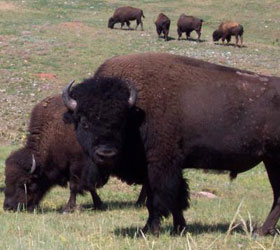Ancient bison teeth provide window on past Great Plains climate
Ancient bison teeth provide window on past Great Plains climate
University of Washington
August 7, 2006
A University of Washington researcher has devised a way to use the fossil teeth of ancient bison as a tool to reconstruct historic climate and vegetation changes in America’s breadbasket, the Great Plains.
The teeth hold evidence of the type of vegetation that grew in a particular location at a particular time, and that in turn provides information about climate fluctuations occurring on the plains, said Kathryn Hoppe, a UW acting assistant professor of Earth and space sciences.
“Bison eat mostly grass, so they provide a good way to measure grassland productivity,” Hoppe said. “Much of the rangeland and farmland in this country was originally native grasslands, so if you want to measure how the productivity of agricultural lands has changed over time, bison seem like a good way to go.”
Hoppe and colleagues Adina Paytan and Page Chamberlain of Stanford University found climate evidence in the enamel from third molars of bison, the equivalent to human wisdom teeth. Those teeth form after young bison no longer depend on mother’s milk for nutrition, and so carry clearer signals of what types of grass the animals consumed.

American bison graze in Wind Cave National Park in South Dakota. Photo by Kathryn Hoppe. RELATED Climate change brought tropical forest to Wyoming Climate change 55 million years ago caused significant changes in forest composition and the distribution of mammals according to a new study in Science. The Paleocene-Eocene Thermal Maximum, in which temperatures rose by as much as 10 degrees in a relatively short period of time, helped bolster the “Age of Mammals,” which included the first appearance of modern primates. After an initial period of increasing aridity in northern latitudes like the study site of Bighorn Basin in northwestern Wyoming, it appears that forests transitioned towards warm tropical ecosystems with closely spaced trees, ideal for the evolution of primates. |
The researchers used bison teeth collected in Montana, Wyoming, North and South Dakota, Nebraska, Kansas and Oklahoma. They pulverized enamel from tooth surfaces and dissolved samples in acid to release small amounts of carbon dioxide. Then they used a mass spectrometer to examine the ratio of the isotopes carbon-12 to carbon-13. Different grasses, those that grow in warm and cool seasons for example, have different isotope ratios.
The results provided a means to reconstruct temperature patterns for particular locations at particular times, Hoppe said. Tooth enamel also carries evidence of changes in carbon dioxide levels, which helps scientists to see how levels of that greenhouse gas changed over time.
Bison roamed North America from Alaska to Mexico going back 200,000 years. They were the most abundant herbivores following the last ice age until Europeans began to settle the continent. Because there were so many over such a large territory, Hoppe said, bison are an ideal means to study how climate and vegetation fluctuated over thousands of years.
Scientists know there have been major periods of climate change on the Great Plains numerous times in the past, typically on a much greater scale than the conditions that created the Dust Bowl in the 1930s. But questions remain about how sensitive the plains are to climate change, and how much of a change might trigger their conversion to desert.
“We know from looking at evidence of past climatic conditions that we currently are in a warm period and that climates have changed dramatically. There have been times in the past, for example, when the climate was so dry that northern Nebraska was a desert with sand dunes. The Sand Hills are a remnant of that time,” Hoppe said. “The better we understand what happened in the past, the better we can predict what will happen in the future,” she said.
The work also provides a way to test current climate models, she said. As scientists develop a more precise understanding of past climate, they can add those conditions as variables to see if the models correctly show what happened. If the models are successful in correctly showing past climate, there is much greater confidence that they are accurate in showing what future climate is likely to be.
The is a modifed news release from the University of Washington.







